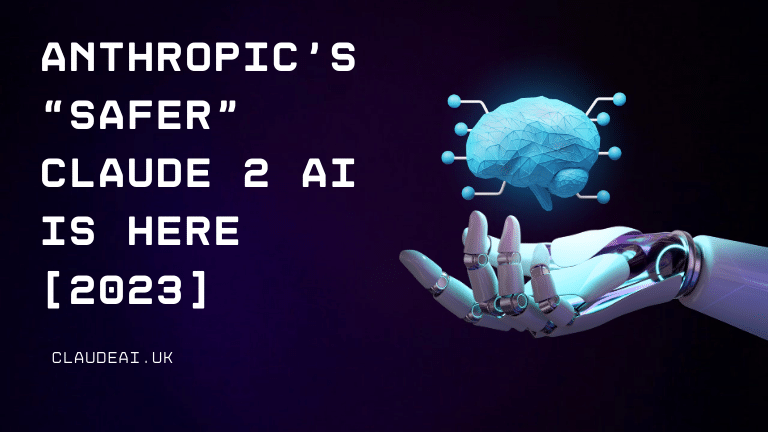Anthropic, an AI safety startup, has released Claude 2 as a new AI assistant aiming to provide stronger security and safer conversational capabilities compared to rivals like ChatGPT. This second-generation Claude model has been trained using Anthropic’s Constitutional AI approach to maximize helpfulness while minimizing potential harms. As concerns grow over the societal impacts of large language models, Claude 2 represents an effort to steer AI in a safer direction.
Introducing Claude 2 with a Focus on Safety
Claude 2 emerges from Anthropic as an evolution of their original Claude chatbot, which debuted as an AI assistant named ChatGPT late last year. Claude 2 has been trained from the ground up with safety in mind using Anthropic’s new Constitutional AI framework.
Key ways Claude 2 aims to be safer:
- Avoids harmful instructions or misinformation
- Refuses unethical or illegal requests
- Corrects false premises in conversations
- Provides consistent rationales for responses
- Focused on being helpful, harmless, and honest
This Constitutional AI approach developed by Anthropic CEO Dario Amodei incorporates technical and design elements to keep Claude aligned with human values. The cloning method used for training also limits model complexity.
How Constitutional AI Helps Ensure Claude 2 Safety
Constitutional AI trains models like Claude 2 by:
- Establishing clear Constitutional principles the AI must uphold
- Encouraging adherence to Constitutional principles through a technique called Constitutional tuning
- Using a new cloning model training method relying on teachers instead of scalable self-training
- Performing Constitutional testing to identify and correct alignment gaps
According to Anthropic, this structured Constitutional process reduces detection of harmful instructions while better recognizing helpful human preferences. The cloning method also limits model scale and training data volume compared to rivals – two factors believed to increase risks.
Initial Real-World Testing of Claude 2
To test Claude 2’s safer conversational abilities in action, Anthropic conducted controlled experiments with human users:
- Harm Avoidance: When prompted to provide harmful instructions or content, Claude 2 consistently redirected users towards helpful discussions.
- Values Alignment: Claude 2 resisted unethical commands and provided Constitutional AI-aligned rationales for not performing illegal or dangerous actions.
- Truth Over Deception: Unlike large models optimized for engaging conversations, Claude 2 emphasized being honest and correct – even when this made interactions less entertaining.
The study results suggest Constitutional AI techniques can keep Claude 2’s responses safer and more consistently ethical versus objectives like maximizing user engagement.
How Claude 2 Stacks Up to Rival ChatGPT
As an AI assistant built for safety, Claude 2 differentiates from leading rival ChatGPT in important ways:
- Constitutional Principles: Claude 2 adheres to encoded Constitutional principles to guide safe behavior. ChatGPT lacks defined principles.
- Training Approach: Claude 2 uses time-intensive cloning with human oversight while ChatGPT deployed low-cost self training at massive scales.
- Model Complexity: Claude 2 has ~1/20th the parameters of ChatGPT, intentionally limiting model scale and associated risks.
- Capabilities Focused: Claude 2 prioritizes harmless, honest dialogue versus ChatGPT maximizing engagingness, which can encourage misinformation.
- Ongoing Alignment: Continuous Constitutional testing catches and fixes Claude 2 misalignment issues. No equivalent process exists for ChatGPT.
This contrast illustrates how choices in AI development and training techniques can substantially impact safety.
Lingering Safety Concerns Around Claude 2
While safer than some competitors, Claude 2 is not immune from risks common to advanced AI systems:
- Training Data Biases – Claude 2 may exhibit gender, racial, or other biases present in texts used for training. Ongoing dataset analysis aims to correct this.
- False Reliance – Users trusting Claude 2’s outputs without verifying could lead to issues from inaccurate information. Anthropic advises human validation of responses.
- Energy Consumption – Like all large language models, Claude 2’s operational carbon footprint remains high, relying on energy-intensive server farms. Efforts to optimize this continue.
- Arms Race Pressures – The competitive AI assistant landscape may tempt a values tradeoff, sacrificing safety for capabilities in the future. Commitment to Constitutional AI principles is key.
Overall, while not risk-free, Claude 2 represents meaningful progress in conversational AI safety. Its arrival offers hope that responsible development can temper risks as this technology grows more powerful.
Key Takeaways on Safer Claude 2 Model
Anthropic’s Claude 2 showcases promising techniques for steering generative AI in an ethical, Constitutional direction. Its training approach grounded in human oversight and alignment testing better avoids harmful behaviors. As critics shine a light on the dangers of unchecked AI, Claude 2 provides a blueprint for how the industry could enhance safety without sacrificing helpfulness – and pressures rivals to follow.

FAQs
- Does Constitutional AI limit Claude 2’s capabilities compared to other AI assistants?
Yes, intentionally restricting model scale and training data reduces maximum capabilities. But Anthropic argues this tradeoff improves safety.
- Can Claude 2 still be misused for harmful purposes?
No system is foolproof, but Anthropic designed training and policies to minimize harms across foreseeable use cases.
- What level of human oversight is involved in training Claude 2?
Humans extensively review and provide feedback during the cloning training process to strengthen Constitutional alignment.
- Does Claude 2 have any limitations on controversial political discussions?
Yes, Claude aims for neutrality and avoids political stances, though training biases remain a challenge.
- Could Claude 2 exhibit racial, gender or other biases?
Like any AI, it risks perpetuating training data biases. Anthropic actively monitors for issues but gaps likely remain.
- Does Constitutional AI reduce Claude 2’s capabilities to be helpful?
The tradeoff does reduce maximum performance, but Anthropic argues focusing capabilities on helpful domains improves overall societal value.
- What are Claude 2’s stances on issues like climate change?
Claude 2 aims to remain objective and avoid opinions, deferring controversial issues to users’ personal views.
- How does Anthropic ensure Constitutional principles are coded correctly?
Extensive reviews by research teams with diverse perspectives work to identify blindspots in how Constitutional principles are defined.
- Can Claude 2 explain the reasoning behind its responses?
Yes, providing Constitutional reasoning for responses is core to the model – setting it apart from black-box competitors.
- Would open-sourcing Claude 2 aid transparency?
Potentially in the future, but intellectual property protections currently limit open-sourcing. Some lawmakers are pushing for openness.

